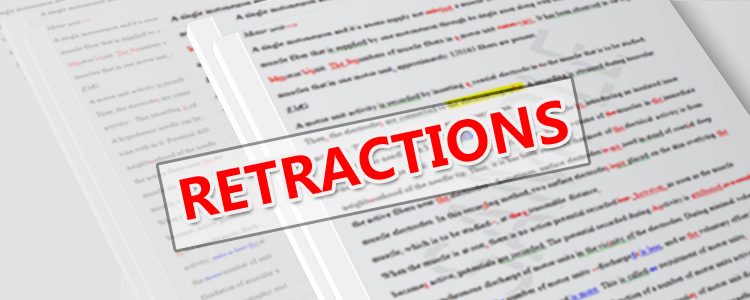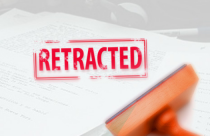Analysis of Retractions in Korean Journals

Publishing research is essential to the growth of the scientific community. Published findings often serve as the basis for future investigations allowing scientists to build on the work of their colleagues around the world. It is therefore critical that errors in published data are corrected as soon as possible and when these errors render the results and conclusions of a paper unusable, it then becomes important to retract the paper.
According to the Committee on Publication Ethics (COPE), papers should be retracted if the data is unreliable or has already been published and then plagiarized, or it constitutes unethical research. COPE defines retraction as “a mechanism for correcting the scientific literature and alerting the readers to publications that publish such seriously flawed or erroneous data that their findings and conclusions cannot be relied upon.” Retractions prevent future experiments from being planned based on faulty data. Retraction notices, among other things, should be linked to the retracted article, published promptly, and be made freely available.
The Korean Situation
A recent publication analyzed retractions in the KoreaMed database. Unlike the PubMed analyses, there was no steady increase in the number of retractions over time. However, there were spikes in the number of retractions in 2007 and 2011. Almost three-quarters of the retractions were issued with the input of the authors, which is similar to retractions in PubMed. The most striking difference between retractions in KoreaMed and PubMed is the proportion of retractions issued because of duplicate publications.
In PubMed, 16% of retractions were due to duplication while in KoreaMed this figure was 58%.
As examples, retraction notices have been issued for plagiarism of a cardiology review, and duplication in a black hole paper. Retractions can be the result of scientific misconduct (such as falsifying data) or honest error. The Korean government’s definition of misconduct includes fabrication, falsification, authorship dispute, plagiarism, and other inappropriate research activities.
Using this definition, 75% of the retractions were due to misconduct. Data falsification was not included as a reason for issuing a retraction notice in KoreaMed. This may be because it represents less than 1% of all journals. Also, scientists that were involved in falsifying data would choose to publish in higher impact journals not represented by KoreaMed.
Appropriate Retractions
The purpose of retraction is to ensure the integrity of the published record and therefore it is important that retractions only be issued where necessary. The COPE guidelines should assist editors in making this decision. If the error in the paper does not significantly affect its results or conclusions, or if a small section was plagiarized, publishing an erratum or corrigendum would be more appropriate. In the case of a duplicate publication, COPE recommends that notice of duplicate publication be included with the original paper and that the second paper be retracted.
According to the authors analyzing the Korean retractions, 45% of the retraction notices were compliant with the COPE guidelines. However, it could not be determined if the retractions were appropriate in 33% of the cases. In 23% of the retractions, the COPE guidelines were not followed. This was the first paper to assess whether or not editors were using the COPE guidelines when deciding to issue a retraction notice. Greater compliance is needed in Korea and similar studies of compliance rates in other regions of the world should also be conducted.
There were several ways in which some of the editors of KoreaMed journals did not comply with the guidelines. In some instances, articles that could have been corrected using an erratum were retracted, partial retractions were issued or the first article published was retracted in cases of a duplicate publication.
Future of Retractions
Retraction is an indication that journals take their role as guardians of the publication record seriously. However, it is important that the editors are trained in the COPE guidelines in order to raise the compliance rates of journals around the world. This will ensure that retractions are not issued as an over-reaction and that the process is fair regardless of which journal issues the retraction notice. There are many mechanisms to ensure that the body of scientific literature is reliable.
For honest errors in small sections of a paper, editors can issue a correction in order to comply with the COPE guidelines. If there is inconclusive evidence of misconduct, if the authors’ institution refuses to investigate despite evidence of misconduct, if there is reason to believe an investigation of misconduct would be unfair, partial or inconclusive, or if the findings of an investigation is likely to be significantly delayed, an editor could issue an expression of concern.
Of course, when the data is sufficiently flawed, a retraction must be issued. In order to best serve the scientific community, each retraction notice should give the reason for the retraction, the person(s) issuing the retraction, and should be published in all versions of the article. Retraction notices, and the accompanying retracted article should also be made freely available. When retractions are issued for articles that have been published online only, the retraction notice and the original article should both be maintained online. There is no need to publish the article and its retraction in physical copies of the journal. Disputes concerning authorship do not warrant a retraction. The editor can simply issue a correction to the author list upon receiving proof that such a change is needed.
The analysis of the retractions in KoreaMed has revealed some important trends which include the high proportion of duplicate publications and misconduct (as opposed to an honest error) among articles. Also, this paper is the first to assess COPE compliance. It is also critical that editors in Korea and elsewhere are trained to ensure compliance with the COPE recommendations as this will ensure global uniformity in how editors protect the integrity of scientific literature.









